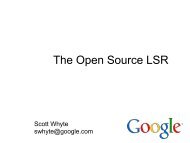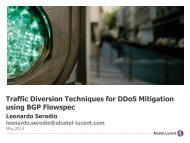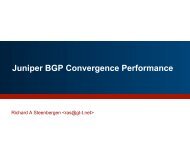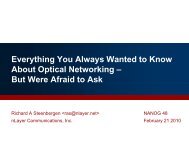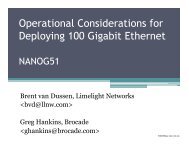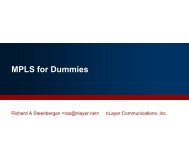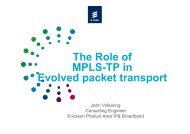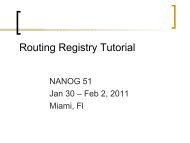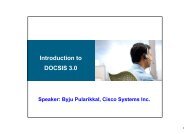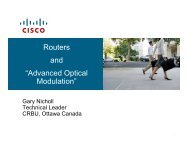IPv6 Unique Local Addresses: The Rant Ted Hardie - Nanog
IPv6 Unique Local Addresses: The Rant Ted Hardie - Nanog
IPv6 Unique Local Addresses: The Rant Ted Hardie - Nanog
You also want an ePaper? Increase the reach of your titles
YUMPU automatically turns print PDFs into web optimized ePapers that Google loves.
<strong>IPv6</strong> <strong>Unique</strong> <strong>Local</strong> <strong>Addresses</strong>:<br />
<strong>The</strong> <strong>Rant</strong><br />
<strong>Ted</strong> <strong>Hardie</strong>
What are ULAs?<br />
● A way of permanently embedding routing policy<br />
in part of the unicast address range for <strong>IPv6</strong><br />
● An opportunity for the Team Cymru bogon list to<br />
add a couple trillion /48s, give or take<br />
● A chance for folks who really enjoyed the happy<br />
times they had configuring RFC 1918 addresses<br />
and NATS to retain those joys into <strong>IPv6</strong>-land.<br />
● Basically, ULA is a TLA that decomposes into<br />
“Tragedy of the Commons”
No, really, what are ULAs?<br />
● RFC 4913 sets aside FC00::/7 as a common prefix<br />
for unicast <strong>IPv6</strong> addresses you can make up for<br />
yourself. <strong>The</strong>re is a pseudo-random function<br />
provided, to avoid collisions. Chances of collision:<br />
Connections Probability<br />
2 1.81*10^-12<br />
10 4.54*10^-11<br />
100 4.54*10^-09<br />
1000 4.54*10^-07<br />
10000 4.54*10^-05<br />
● <strong>The</strong>re are just a bit over 2 trillion /48s in the ULA<br />
/7. Half is used in the psuedo-random scheme.<br />
<strong>The</strong> other half is set aside for later specification.
Why addresses you make up for<br />
yourself: some ancient history.<br />
● <strong>The</strong> original <strong>IPv6</strong> addressing architecture (RFC<br />
1884) defined two types of local use unicast<br />
addresses: link-local and site-local. Link local<br />
was for links without a router and site-local for:<br />
“sites or organizations that are not (yet) connected to the<br />
global Internet. <strong>The</strong>y do not need to request or "steal"<br />
an address prefix from the global Internet address<br />
space. <strong>IPv6</strong> site-local addresses can be used instead.<br />
When the organization connects to the global Internet,<br />
it can then form global addresses by replacing the sitelocal<br />
prefix with a subscriber prefix.”<br />
● Site-local stayed in RFC 2373 and 3513, but<br />
changed from a prefix for disconnected sites to<br />
one used above the link and below the Internet.
Since you have 128 bits of addresses,<br />
why not use more than one?<br />
● A core assumption in modern v6 is that there are<br />
commonly multiple addresses associated with a<br />
physical interface. Link and global make sense.<br />
● “site” in the v6 architecture has never been well<br />
defined. <strong>The</strong>re were years of arguments over it<br />
that just churned.<br />
● <strong>The</strong>re is no necessary relationship between a “site”<br />
and anything in the routing system. <strong>The</strong> “site” is a<br />
latchkey child that resulted from a divorce<br />
between routing and addressing. That means<br />
whatever you define a site to be is arbitrary<br />
requires a lot of administrative work to maintain.
Ratemynetworkdiagram.com site
Site-local got killed, slowly<br />
● <strong>The</strong> pain of RFC 1918 addresses convinced<br />
applications and operations folks that site-local<br />
was a bad, bad notion. After a lot of heated<br />
debate, plenary argument, appeals, and<br />
escalations, they won the argument inside the<br />
IETF and site-local was killed in RFC 3879.<br />
● 3879 identified several kinds of site-local pain:<br />
ambiguity & scope identifiers for applications;<br />
leakage for operators; complexity for routers.<br />
● <strong>The</strong> <strong>IPv6</strong> folks were told to go back and try again.<br />
● ULAs are the result.
ULA: Son of site-local<br />
● This design fixes one thing: ambiguity.<br />
● Fixing the ambiguity created some serious scope<br />
creep, though. Where “site-local” was theoretically<br />
filtered at the border of whatever a site meant,<br />
ULAs are now defined to allow interconnect<br />
among sites, as long as the routes to do so don't<br />
traverse the public Internet.<br />
● In other words, this ties a routing policy to a<br />
portion of the address space which is otherwise<br />
indistinguishable from the global scope.
In other other words, ULAs=PI space<br />
● ULAs are “provider independent” at a very basic<br />
level—you generate them yourself, rather than<br />
getting them from an upstream or RIR.<br />
● <strong>The</strong>y are not PI space in the sense we usually<br />
mean, in that holders of ULAs theoretically do not<br />
have the ability to announce these or implement<br />
their own routing policies.<br />
● But the only thing keeping them from being “PI<br />
space” in both senses is upstreams' unwillingness<br />
to announce these /48s into the <strong>IPv6</strong> DFZ.
Why should you be unwilling?<br />
● Because you don't want to accept other folks'<br />
announcements of ULAs. <strong>The</strong>re is no policy check<br />
here. Once the dam breaks,your competitor can<br />
sell your routing slot for one at whatever price he<br />
wants, and tragedy of the commons pricing will<br />
hurt everyone, fast. Eaten any good cod, lately?<br />
● Even if you're getting a cut, this is a bad choice as<br />
ULAs can't ever be aggregated. Current ARIN PI<br />
policy ahas a minimum direct assignment of /48,<br />
but out of blocks reserved up to /44.<br />
● For connected sites, ULAs are mostly in addition<br />
to global addresses. Adding interface addresses<br />
hurts applications. See ICE for a scary example.
Conclusion:<br />
● ULAs are globally unique unicast addresses with a<br />
built-in routing policy. <strong>The</strong>re is nothing you can<br />
do with them that you can't do with normal globalscope<br />
addresses and your own policies.<br />
● What you should do:<br />
– Disallow FC00::/7 from peers now.<br />
– Discourage any customers you have from using it.<br />
Show them how to split their global address space into<br />
routed and unrouted if you need to.<br />
– Tell them you will filter ULAs if they are announced to<br />
you, and do so.<br />
● Praise your local RIR for having PI space for<br />
customers available under known policies.
Is there anything good about ULAs?<br />
● You can generate a ULA and list it in your posts to<br />
Digg, Fark, or Slashdot without causing heartburn<br />
for Jay Adelson, Drew Curtis, or CmdrTaco.<br />
● Reading one aloud is less likely to hurt your vocal<br />
cords than an actual ululation.<br />
● Breaking open a package covered by one does not<br />
limit anyone's liability, extend anyone's copyright,<br />
or constitute an agreement to sell your soul at a<br />
discount price.<br />
● That's about it.



